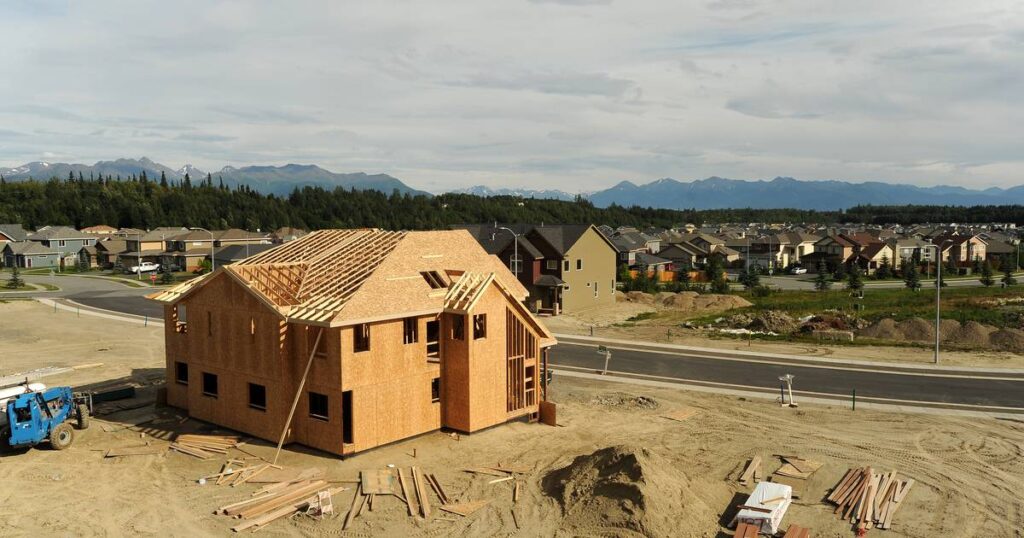Andrea Feniger, Chantal de Alcuaz, Isaac Vanderburgh, Janet Leigh, Pamela Miller
Updated: 1 hour ago Published: 1 hour ago
![]()
Pro-housing reforms like Anchorage's HOME initiative give residents more flexibility in how they use their properties, cut red tape for developers, and help ease historically high housing prices. Don't miss out on the environmental benefits of HOME, too.
Modifying Anchorage's zoning code to encourage compact development is one of the most effective ways to achieve the goals set out in the 2020 Climate Action Plan. Poor urban planning accelerates climate change by forcing people to travel long distances for work and recreation. Laws that effectively mandate single-family homes and prevent efficient land use increase greenhouse gas emissions per capita. And building on green spaces destroys natural carbon sinks like trees and tundra. HOME takes a modest step toward climate-smart zoning by allowing duplexes in all Anchorage Bowl neighborhoods. Allowing four-family and larger units would have an even greater positive impact, and we hope the City will eventually do so. HOME remains a win-win for any organization or individual interested in climate change, and we hope you will support it.
In Anchorage, overly complicated zoning requirements have prevented developers from building carbon-efficient neighborhoods. HOME would remove the most significant barrier: rules that limit more than 41% of Anchorage's parcels to single-family homes, the least efficient and most expensive land use. These rules push development to the outskirts of town and beyond, increasing emissions and transportation costs. HOME would enable a gradual transition to more efficient land uses by legalizing two-family homes citywide.
HOME helps the environment in three ways:
First, encouraging higher density construction in Anchorage allows more workers to live in the city instead of commuting from the Mat-Su Valley. Second, apartment buildings are much more efficient from a construction and heating standpoint than single-family homes, which is especially important in the gas-shortage situation in Cook Inlet. Third, allowing higher-value development in existing areas relieves the financial pressure to build on farmland and wild space.
HOME is part of the answer to Anchorage's affordable housing crisis. Anchorage home prices soared 30% between 2019 and 2023. The lack of affordable options in town has driven many young people and working families to move north to Mat-Su, where seven homes are added per 1,000 residents each year (compared to only 1.3 in Anchorage). For the past nine years, more people are moving out of Anchorage than moving into it. In 2021, 2,932 Anchorage residents moved into the borough (1,517 Mat-Su residents moved into the city). Anchorage's affordable housing shortage doesn't just force Alaskans into a long, expensive and dangerous commute down the Glenn Highway; it also exacerbates the climate crisis. A daily round-trip commute from Palmer to Anchorage emits 17,500 pounds of carbon dioxide per year, well above the national average. Allowing higher density housing in the Anchorage Bowl would allow more families to live in town.
Multifamily homes use resources more efficiently than single-family homes. Building a single-family home requires much more raw materials and carbon dioxide emissions per resident than a duplex or apartment shared by two or more families. The same is true for heating, which is especially important in the winter city we live in (think small units and shared walls). Over 96% of homes in Anchorage use natural gas for heating. Unfortunately, natural gas is scarce in Cook Inlet, and imported gas could be 50% more expensive than the local gas we currently use. That means it's time to build thermally efficient homes in Alaska. If you want affordable heating, you should support HOME. If you want to avoid importing foreign natural gas and building a second pipeline through Interior Alaska, you should support HOME.
Finally, HOME protects local agriculture and natural spaces by limiting further sprawl in sensitive hill country. There is housing demand in Southcentral Alaska, and developers have two choices for where to build that housing. Developers can fill unused parking lots, abandoned buildings and vacant lots within Anchorage city limits. Or new housing could replace farms and natural spaces on the outskirts of town. Which would you choose? Unfortunately, restrictive zoning rules and high construction costs make it nearly impossible for developers to build in downtown Anchorage neighborhoods. The only homes they can make a profit on are mansions on the outskirts of town. HOME changes the economic calculus for developers because two-family homes are more valuable than single-family homes.
Whatever your area of support – smaller government, lower housing costs or climate-friendly neighborhoods – please consider testifying in person or emailing your council member in support of HOME at the council meeting on Tuesday, June 25th.
Andrea Feniger, Alaska Chapter Chair, Sierra Club of Alaska; Chantal de Alcuaz, Alaska Center; Isaac Vanderburg, Launch Alaska; Janet Lee, Alaska Research Director, Sightline Institute; Pamela Miller, Alaska Toxic Materials Community Action;
Opinions expressed here are those of the author and are not necessarily endorsed by the Anchorage Daily News, which welcomes a wide range of viewpoints. To submit an article for consideration, email commentary(at)adn.com. Submissions of under 200 words may be sent to letters@adn.com or click here to submit from any web browser. Read our complete guidelines for letters and commentary here.



